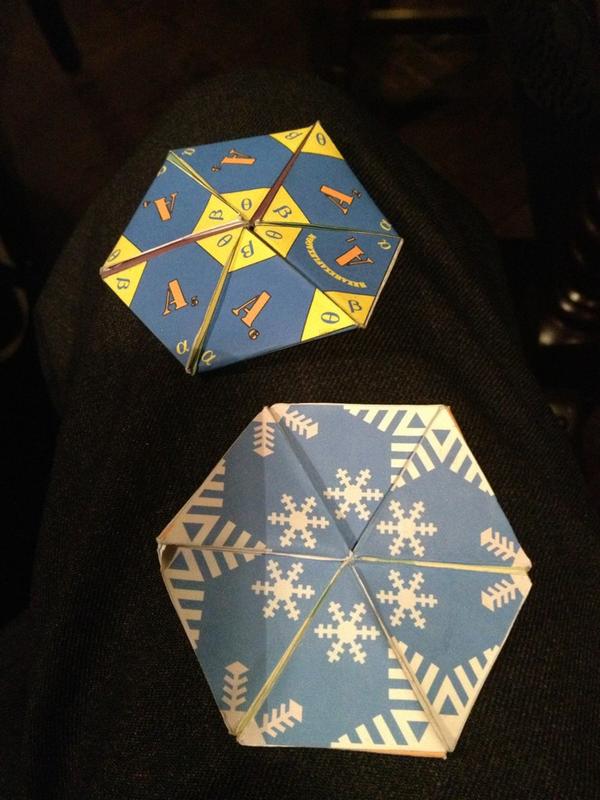Last Sunday saw the anniversary of the birth of Martin Gardner, and as a celebration, the Gathering for Gardner people planned a world-wide party ‘G4G Celebration of Mind‘. It happened to be Maths Jam night on Tuesday, so we put the Nottingham Maths Jam on the G4G-COM map. Then on Friday three of us had agreed to take a puzzles stall to the Nottingham STEM Pop Up Shop, so I added this to the map as well.
A Celebration of Mind party is supposed to “celebrate the legacy of Martin Gardner on or around Sunday, October 21, 2012 through the enjoyment of [one or more of] Puzzles, Magic, Recreational Math, Lewis Carroll, Skepticism and Rationality”.
At Maths Jam I printed a bunch of flexagon material from the Flexagon Party page. I also had a plan: having finished two jobs in recent years with piles of business cards outstanding, I brought these to try some business card origami. In fact, we decided to make a business card Menger sponge. So we started folding.
 |
| Business card folding begins |
Meanwhile, John Read had come equipped with some colourful designs to make hexahexaflexagons.
 |
| John Read’s first hexahexaflexagon of the evening. Designs from flexagon.net. |
 |
| John Read’s second hexahexaflexagon. Designs from flexagon.net. |
At the same time, Jon made a trihexagon.
 |
| Trying to make a triflexagon |
Finally, after much business card folding,we had a Menger sponge* (*not a real one, it being a fractal after all!). Here it is, in Maths Jam-style, balanced on a pint of beer.
 |
| The completed business card Menger sponge |
And here’s a shot through the Menger sponge, where a geometry puzzle is being attempted.
 |
| Through the completed business card Menger sponge, some geometry is happening |
Here are a couple of the other puzzles that we tried, some from the #MathsJam tag on Twitter:
You have 100 coins, 10 of which are showing heads and 90 of which are showing tails (though these are indistinguishable by touch). Blindfolded, you must divide the coins into an even number of heads and tails.
Which is bigger, 3^(21!) or 2^(31!)?
Then on Friday we made our way to Broadmarsh shopping centre for our afternoon at Nottingham’s STEM Pop Up Shop.
 |
| Nottingham STEM Pop Up Shop welcome notice |
Here’s a picture of our stall, with Kathryn Taylor presiding, and in the foreground the posters about Martin Gardner, mathematical games and mathematicians that I had printed. Someone did ask me who Martin was and I explained a little; I think I also convinced him to come to Robin Wilson’s talk on Lewis Carroll next month in Derby.
 |
| Martin Gardner posters on our stall |
Here’s the detail of our stall, which we called ‘Solving it like a mathematician’. You can get details of the set of puzzles on my website.
 |
| The STEM Pop Up Shop ‘Solving it like a mathematician’ stall |
Looking around the shop, I requisitioned the Alan Turing postcards from the ‘My Favourite Scientist’ set for our stall!
 |
| Alan Turing postcards |
Here’s a wider view of the stall, with Kathryn entertaining a customer.
 |
| Kathryn Taylor at our stall |
And finally, here’s John Read bewitching a crowd with the loop on a chain trick.
 |
| John Read enthuses a crowd with a ring on a chain |
Thank you for reading!
 |
| Thank you for visiting |






